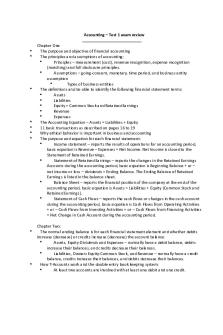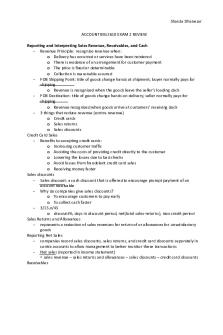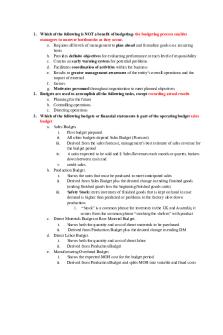Accounting – Test 1 exam review PDF

| Title | Accounting – Test 1 exam review |
|---|---|
| Course | Principles Of Accounting |
| Institution | Old Dominion University |
| Pages | 2 |
| File Size | 56.6 KB |
| File Type | |
| Total Downloads | 50 |
| Total Views | 156 |
Summary
Accounting 201s test 1 exam review...
Description
Accounting – Test 1 exam review
Chapter One The purpose and objective of financial accounting The principles and assumptions of accounting: Principles – measurement (cost), revenue recognition, expense recognition (matching) and full disclosure principles. Assumptions – going-concern, monetary, time period, and business entity assumption Types of business entities The definitions and be able to identify the following financial statement terms: Assets Liabilities Equity = Common Stock and Retained Earnings Revenue Expenses The Accounting Equation – Assets = Liabilities + Equity 11 basic transactions as described on pages 16 to 19 Why ethical behavior is important in business and accounting The purpose and equation for each financial statement: Income statement – reports the results of operations for an accounting period, basic equation is Revenue – Expenses = Net Income. Net Income is closed to the Statement of Retained Earnings. Statement of Retained Earnings – reports the changes in the Retained Earnings Accounts during the accounting period, basic equation is Beginning Balance + or – net income or loss – dividends = Ending Balance. The Ending Balance of Retained Earnings is listed in the balance sheet. Balance Sheet – reports the financial position of the company at the end of the accounting period, basic equation is Assets = Liabilities + Equity (Common Stock and Retained Earnings). Statement of Cash Flows – reports the cash flows or changes in the cash account during the accounting period, basic equation is Cash Flows from Operating Activities + or – Cash Flows from Investing Activities + or – Cash Flows from Financing Activities = Net Change in Cash Account during the accounting period. Chapter Two: The normal ending balance is for each financial statement element and whether debits increase (decrease) or credits increase (decrease) the account balance: Assets, Equity-Dividends and Expenses – normally have a debit balance, debits increase their balances, and credits decrease their balances. Liabilities, Owners Equity-Common Stock, and Revenue – normally have a credit balance, credits increase their balances, and debits decrease their balances. How T-Accounts work and the double entry book keeping system: At least two accounts are involved with at least one debit and one credit.
The total amount debited must equal the total amount credited. The accounting equation must not be violated. Transactions are recorded first in a journal and in posted to accounts in the General Journal. The 16 example transactions described on pages 61 through 65. How to develop a trial balance by taking the ending balances from the General Ledger Account balances. How to use the trial balance to prepare the financial statements using the financial statements basic equation learned in chapter one. The formula for the debt ratio. Chapter Three: The purpose of adjusting entries – to adjust the cash basis accounts to the accrual basis. How to make adjusting entries for prepaid assets (Insurance and Rent. Depreciation, Unearned (Deferred) Revenues, Accrued Expenses (Salaries and Interest, Accrued Revenues (Rent and Interest) on pages 101 to 108. How to make closing entries. The purpose of the Income Summary Account. The sections of a classified balance sheet....
Similar Free PDFs

Accounting – Test 1 exam review
- 2 Pages

Accounting Exam 1 Review
- 3 Pages

Accounting 1 Final Exam Review
- 15 Pages

Accounting 201 Exam 1 Review
- 3 Pages

Test Review Exam 1- accoutning
- 12 Pages

Accounting Exam 2 Review
- 10 Pages

Accounting Exam 2 Review
- 17 Pages

Accounting Exam 2 Review
- 8 Pages

Accounting 1 Exam 2 Review notes
- 21 Pages

Accounting 1 Review
- 4 Pages
Popular Institutions
- Tinajero National High School - Annex
- Politeknik Caltex Riau
- Yokohama City University
- SGT University
- University of Al-Qadisiyah
- Divine Word College of Vigan
- Techniek College Rotterdam
- Universidade de Santiago
- Universiti Teknologi MARA Cawangan Johor Kampus Pasir Gudang
- Poltekkes Kemenkes Yogyakarta
- Baguio City National High School
- Colegio san marcos
- preparatoria uno
- Centro de Bachillerato Tecnológico Industrial y de Servicios No. 107
- Dalian Maritime University
- Quang Trung Secondary School
- Colegio Tecnológico en Informática
- Corporación Regional de Educación Superior
- Grupo CEDVA
- Dar Al Uloom University
- Centro de Estudios Preuniversitarios de la Universidad Nacional de Ingeniería
- 上智大学
- Aakash International School, Nuna Majara
- San Felipe Neri Catholic School
- Kang Chiao International School - New Taipei City
- Misamis Occidental National High School
- Institución Educativa Escuela Normal Juan Ladrilleros
- Kolehiyo ng Pantukan
- Batanes State College
- Instituto Continental
- Sekolah Menengah Kejuruan Kesehatan Kaltara (Tarakan)
- Colegio de La Inmaculada Concepcion - Cebu





